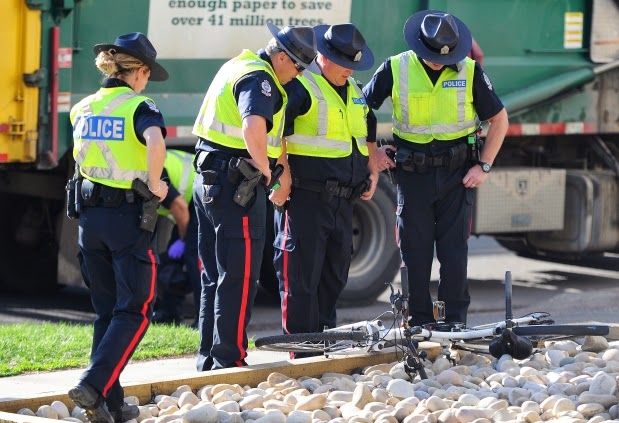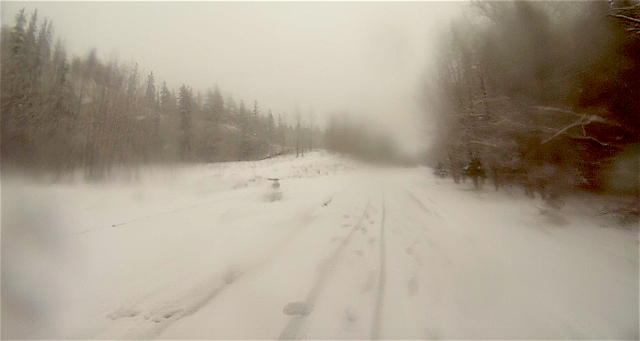A Cyclist Was Killed: Some Preliminary Thoughts
A cyclist was killed this morning in Edmonton, and some of the usual things have happened.
There is a ghost bike chained to a pole at the scene of the collision. Chris, good work.
The news has covered the event, setting the scene with sentences like "A sunny morning commute turned tragic on Thursday" and "A 50-year-old woman is dead after being struck by a garbage truck while riding her bike Thursday morning."
And the photos that are the latest in the bicycle-turned-headstone-as-mourners-who-used-to-be-kids-on-bikes-look-on series.
There is the usual kind of statement from the police investigator about not yet being able to determine who was at fault, that the cyclist had a helmet on, and so on.
The waste management company issued a somewhat predictable statement, writing, in part, that "our two drivers are seasoned professionals and have been, and will continue to, cooperate in working with local authorities to further investigate this incident...Our thoughts and prayers are with the loved ones of the cyclist involved here."
More of the predictable in this assessment on social media: "She fell under the wheels of a garbage truck that was turning right. No side guards. She didn't have a chance."
There are equally sound and equally predictable calls not to politicize the cyclist's death. And just as equally sound and predictable politicizations of the cyclist's death.
There will be decent calls for safer bicycle lanes. (Edmonton does not hit the mark here, for sure, and can do a lot better.) There will be responses about the need to do more study. Opinions will harden.
And it will all add up to so much more of the same. The same deep sadness, the same questions, the same same.
If this all sounds so cynical and apathetic, it's really not. I pedal that same route to work and on some mornings have been at that exact spot at that exact time moving in the same direction. I have encountered massive garbage trucks and whispered quick prayers, which is not to say they are driven unsafely but just that they are as big as your basic stegosaurus. I cycled past the ghost bike a few hours ago on my way home.
I just keep getting the sense that it's good people, but the wrong people, who are trying to keep everyone moving safely. The people who should be on the case are not the politicians and their functionaries but those who see keeping cars and bicycles and garbage trucks moving without incident along roadways as a big, dispassionate, coder's puzzle. Just like moving packets of information smoothly from point to endpoint on the net.
On brutal days like this, I feel—and this is not to ascribe fault as we understand fault—that ascribing fault is such a waste of time. That it is so much after the fact. That it does little to undo the terrible ratio that a traffic fatality is; that is, a mistake equals a loss of life on one side, and a mistake equals a ruined or scarred life on the other. And that it makes more sense to design our way to safety than moan and mourn without seeming effect or, possibly worse, design laws in words that can only punish, not prevent.
To do that, though, to turn in that direction, we have to consider a somewhat unpredictable change in how we view the automobile and the automobile driver, I think. Here is the contention: a driver of an automobile is, in truth, a powerful cyborg. He or she is connected to a mighty machine, and connected in a radical way, connected not just as the operator but absorbed into the machine, acted on by the machine as much as he or she purportedly acts on the machine. A human being actually sacrifices freedom by driving.
So, what follows if we see our freedom somewhat attenuated and not enhanced by the act of driving? The door is opened to all kinds of feedback mechanisms and safety devices on the machines that are us to keep those machines from colliding with other moving objects. The door is opened to get beyond blame after the fact to design before the fact.
Seeing vehicles as information communicating from one point to another might lead to the new perspective needed to stop all this too-predictable sadness. Unless that is too high a price.
There is a ghost bike chained to a pole at the scene of the collision. Chris, good work.
The news has covered the event, setting the scene with sentences like "A sunny morning commute turned tragic on Thursday" and "A 50-year-old woman is dead after being struck by a garbage truck while riding her bike Thursday morning."
 |
| How The Journal's great John Lucas saw it |
There is the usual kind of statement from the police investigator about not yet being able to determine who was at fault, that the cyclist had a helmet on, and so on.
The waste management company issued a somewhat predictable statement, writing, in part, that "our two drivers are seasoned professionals and have been, and will continue to, cooperate in working with local authorities to further investigate this incident...Our thoughts and prayers are with the loved ones of the cyclist involved here."
More of the predictable in this assessment on social media: "She fell under the wheels of a garbage truck that was turning right. No side guards. She didn't have a chance."
There are equally sound and equally predictable calls not to politicize the cyclist's death. And just as equally sound and predictable politicizations of the cyclist's death.
There will be decent calls for safer bicycle lanes. (Edmonton does not hit the mark here, for sure, and can do a lot better.) There will be responses about the need to do more study. Opinions will harden.
And it will all add up to so much more of the same. The same deep sadness, the same questions, the same same.
If this all sounds so cynical and apathetic, it's really not. I pedal that same route to work and on some mornings have been at that exact spot at that exact time moving in the same direction. I have encountered massive garbage trucks and whispered quick prayers, which is not to say they are driven unsafely but just that they are as big as your basic stegosaurus. I cycled past the ghost bike a few hours ago on my way home.
It is not easy to know what commonplace attitude or practice from 2014 we will
look back at and dismiss as the product of ignorance or political power in the way that "More Doctors Smoke Camels" was the product of ignorance and political power in its time. But one prime candidate in the running has to be traffic fatalities.I just keep getting the sense that it's good people, but the wrong people, who are trying to keep everyone moving safely. The people who should be on the case are not the politicians and their functionaries but those who see keeping cars and bicycles and garbage trucks moving without incident along roadways as a big, dispassionate, coder's puzzle. Just like moving packets of information smoothly from point to endpoint on the net.
On brutal days like this, I feel—and this is not to ascribe fault as we understand fault—that ascribing fault is such a waste of time. That it is so much after the fact. That it does little to undo the terrible ratio that a traffic fatality is; that is, a mistake equals a loss of life on one side, and a mistake equals a ruined or scarred life on the other. And that it makes more sense to design our way to safety than moan and mourn without seeming effect or, possibly worse, design laws in words that can only punish, not prevent.
To do that, though, to turn in that direction, we have to consider a somewhat unpredictable change in how we view the automobile and the automobile driver, I think. Here is the contention: a driver of an automobile is, in truth, a powerful cyborg. He or she is connected to a mighty machine, and connected in a radical way, connected not just as the operator but absorbed into the machine, acted on by the machine as much as he or she purportedly acts on the machine. A human being actually sacrifices freedom by driving.
So, what follows if we see our freedom somewhat attenuated and not enhanced by the act of driving? The door is opened to all kinds of feedback mechanisms and safety devices on the machines that are us to keep those machines from colliding with other moving objects. The door is opened to get beyond blame after the fact to design before the fact.
Seeing vehicles as information communicating from one point to another might lead to the new perspective needed to stop all this too-predictable sadness. Unless that is too high a price.



Comments
Post a Comment